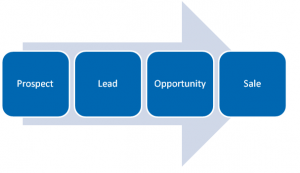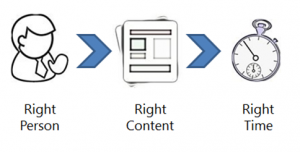Only 5% of leads that come into a business are ready to make a buying decision right now… Sound familiar?
In my role I get to speak to a lot of marketers, from a lot of different businesses, I hear this (or something similar) a lot. When I ask what the number 1 challenge is in terms of marketing to a pipeline, it’s content. Not because they can’t get enough content resource from the business to do any marketing at all (most marketing teams, have access to someone who can write copy), but because they don’t really know how to plan content, or put it to effective use online.
Here are some useful tips I’ve picked up recently to get your content planning started, and also how to put it to good use. Some of these are particularly useful for considered (in other words, long) purchase cycles.
-
Map your pipeline (from marketing through sales to revenue).

Align your marketing and sales teams to make sure that you can take a lead from one end (prospect) to the other (paying customer) without changing the experience they’ve received. A good stat I saw recently, from a survey of B2B buyers, 53% said buying experience was the main driver for decision making, not brand, not the service offering, not even (believe it or not) the price! Tying this stuff together is vital to success.
If you look at your pipeline, you need to try and consider what kind of content that a user at each stage is likely to be interested in.
Early (furthest from decision) – the prospect knows they have a challenge, and are looking to educate themselves to what the potential solutions are. At this stage, they’re likely to be interested in informational content.
Middle – the prospect knows what the challenge well enough to start creating a business case to solve it. At this stage they’ll be looking for buyers guides, and be more open to products and brands – ready to become a lead.
Late– At this time, the prospect has got budget , and is looking for a brand, solution or product that can meet their need – has a quotable opportunity. When we come to planning, we need to think about what content can be produced to support each aspect of this decision making process.
-
Work out who your prospects are and what information they’re looking for. There are some simple ways to do this…
The easy way is to take a sample, and give them a call. Ask them about the challenge they’re trying to solve. This will give you a great starting point for what content to produce.
For a more quantitative view, if you’ve got email data, use a drip campaign (send automated emails) to test subject matter. Send email messages focused on a single service offering, or product, if the user opens and clicks, you’ve found what they’re interested in, if not, send them the next email about a different service.. Rinse & repeat.
If you’ve got lots of data, this will help you quickly segment it into silos of interest.
-
Plan your content creation.
We know what the decision making process looks like, we also know who prospects are, and their potential challenges, so when it comes to planning, the easy way to think of it is like this – We’re aiming to give the right person, the content, at the right time in the buying process.

From a text content perspective, you need to consider where you’re going to get your content from, especially in technical industries. Often there’s lots of great product & solution based knowledge in a business, but getting it out of people is similar to getting blood from the proverbial stone. If this is the case for you, make sure you realise these guys all have full time jobs, and marketing isn’t in their remit. A 10 minute chat (if structured correctly) can often give you more than enough information to deliver high quality web content.
It’s easy to think about content in the form of words, but don’t limit yourself to that. Think white papers, guides, blogs sure, but think outside of that too. Think video, think webinars, think social media.
All of these are great ways to deliver content to your target audience, which leads me nicely on to step 4.
-
Deliver this content to (or ‘nurture’) your pipeline.
The important thing to note is that at this stage it’s not just a hit and hope content delivery. By now we know:
- who’s receiving it
- what their challenge is
- and what content we have to address said challenge
We can monitor the response to this content and as we do, learn even more and start mapping prospects to parts of the pipeline.
If someone responds to an education piece, we can assume they’re early in the buying cycle, so can try calls to action to introduce them to potential solution. If they don’t respond, they probably aren’t ready to take the next step through the pipeline. What more value can you add with content? Do they need more informational/educational content?
If they’re receptive to solution based content (and therefore in the middle of pipeline) will they respond to a specific product based message? If so, they’re taking the step into the last section of the pipeline, and should be passed to sales.
I heard someone recently use an analogy of snake and ladders to describe the nurturing process. We’re looking to get someone to the end of the board as quickly and effectively as possible. Delivering the right content at the right time, will help push the prospect one square along, but what we really want is for the prospect to hit a ladder, (i.e. accelerating them through the pipeline), so we offer them messaging to encourage them in to the next stage of the pipeline. If they don’t respond, consider it a snake, and put them back where they were.
If they’ve engaged with educational content, promote your solution based content to them, if they’ve engaged with solution based content already, try a harder, product or brand based message.
I appreciate this looks like a hefty process, I would suggest starting small. Break these steps into bite size chunks and prove the value along the way. Take the simplest aspect of your business, and test it. If you get it right the results will speak for themselves. If it doesn’t work out first time, don’t quit.
You’ve done your research and planned your perfect content strategy, but let’s not forget the advice from the great Helmuth von Moltke the Elder – “No plan survive first contact with the enemy”.
I think that’s the first time I’ve referred to prospects as ‘the enemy’ but the point stands true, don’t get too attached to your plan. It needs to develop constantly to stay effective. If you can get in the cycle of delivering content against an ever changing plan then you’re on to a winner!
